ACT Exam > ACT Questions > Directions:Read the passages and choose the b...
Start Learning for Free
Directions: Read the passages and choose the best answer to each question.
Passage
Oil and natural gas stores are formed naturally in reservoirs. However, these reservoirs are not like the giant man-made lakes that might come to mind; they are underground. In fact, a reservoir occurs in a rock that looks on the surface like any other. The oil and gas pool in millions of tiny pores in the rock. Porous rocks include sandstone, limestone, shale, and many more. There are several factors affecting porosity (the ability to store fluid in the open spaces located between rock particles). Among these factors are the nature and characteristics of the sand and other sediment that accumulate to form rocks. The sand particle size is not critical to porosity, but the uniformity or sorting of the sand grains greatly effects porosity. Uniform or well-sorted sand will tend to be more porous than poorly sorted sand.
Experiment 1
In a laboratory, a scientist wanted to determine the porosity of 4 samples of different rocks. The scientist recorded the mass of the rock samples prior to the experiment. To measure porosity, the samples were soaked in water and the mass of the samples was recorded periodically. A highly porous rock would have a significant increase in mass the longer it soaked in water, eventually reaching the point at which it could no longer absorb any more water (saturation point). The data was recorded in Table 1.
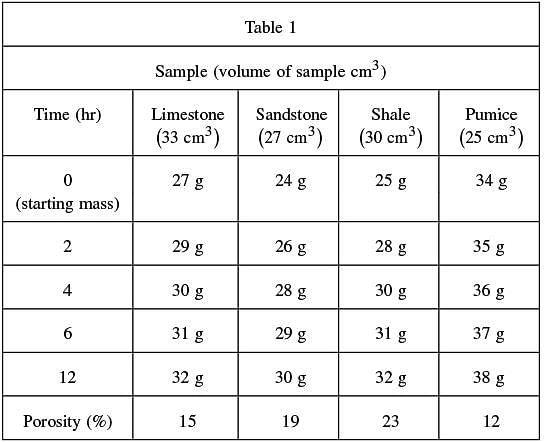
Passage
Oil and natural gas stores are formed naturally in reservoirs. However, these reservoirs are not like the giant man-made lakes that might come to mind; they are underground. In fact, a reservoir occurs in a rock that looks on the surface like any other. The oil and gas pool in millions of tiny pores in the rock. Porous rocks include sandstone, limestone, shale, and many more. There are several factors affecting porosity (the ability to store fluid in the open spaces located between rock particles). Among these factors are the nature and characteristics of the sand and other sediment that accumulate to form rocks. The sand particle size is not critical to porosity, but the uniformity or sorting of the sand grains greatly effects porosity. Uniform or well-sorted sand will tend to be more porous than poorly sorted sand.
Experiment 1
In a laboratory, a scientist wanted to determine the porosity of 4 samples of different rocks. The scientist recorded the mass of the rock samples prior to the experiment. To measure porosity, the samples were soaked in water and the mass of the samples was recorded periodically. A highly porous rock would have a significant increase in mass the longer it soaked in water, eventually reaching the point at which it could no longer absorb any more water (saturation point). The data was recorded in Table 1.

Experiment 2
Geologists in Arizona were interested in the porosities of different varieties of sandstone. They documented the relationship between porosity, density, sand particle size, and the uniformity or sorting of the sand grains. The geologists found that, in general, neither density nor particle size affected the porosity if the particles were uniform. However, they did find that in samples with a wide variety of particle sizes, the porosity was generally lower. Also, the presence of contaminants such as clay or silt negatively Experiment 2 Geologists in Arizona were interested in the porosities of different varieties of sandstone. They documented the relationship between porosity, density, sand particle size, and the uniformity or sorting of the sand grains. The geologists found that, in general, neither density nor particle size affected the porosity if the particles were uniform. However, they did find that in samples with a wide variety of particle sizes, the porosity was generally lower. Also, the presence of contaminants such as clay or silt negatively
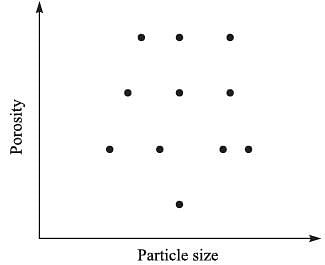
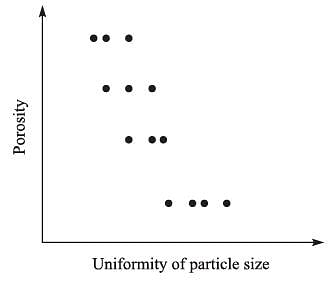
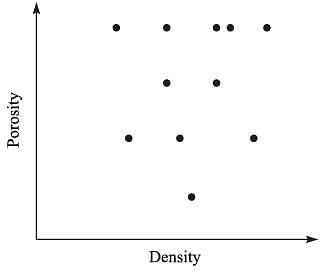
Geologists in Arizona were interested in the porosities of different varieties of sandstone. They documented the relationship between porosity, density, sand particle size, and the uniformity or sorting of the sand grains. The geologists found that, in general, neither density nor particle size affected the porosity if the particles were uniform. However, they did find that in samples with a wide variety of particle sizes, the porosity was generally lower. Also, the presence of contaminants such as clay or silt negatively Experiment 2 Geologists in Arizona were interested in the porosities of different varieties of sandstone. They documented the relationship between porosity, density, sand particle size, and the uniformity or sorting of the sand grains. The geologists found that, in general, neither density nor particle size affected the porosity if the particles were uniform. However, they did find that in samples with a wide variety of particle sizes, the porosity was generally lower. Also, the presence of contaminants such as clay or silt negatively



Q. Which of the following graphs best represents the relationship between time elapsed and saturation of the rocks observed in Experiment 1?
- a)
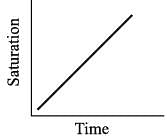
- b)
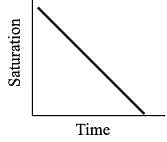
- c)
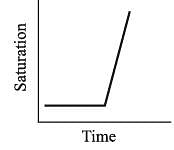
- d)
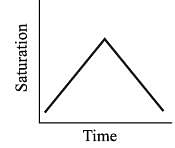
Correct answer is option 'A'. Can you explain this answer?
Most Upvoted Answer
Directions:Read the passages and choose the best answer to each questi...
The best answer is a. The data in Table 1 shows that as time increases, each of the rock samples increases in weight, suggesting that the samples continue to absorb water as they soak. According to the passage, rocks become fully saturated when they can no longer absorb any more water. Therefore, there is a direct relationship between time and saturation, which is indicated by the graph in answer choice a.

|
Explore Courses for ACT exam
|

|
Similar ACT Doubts
Directions:Read the passages and choose the best answer to each question.PassageOil and natural gas stores are formed naturally in reservoirs. However, these reservoirs are not like the giant man-made lakes that might come to mind; they are underground. In fact, a reservoir occurs in a rock that looks on the surface like any other. The oil and gas pool in millions of tiny pores in the rock. Porous rocks include sandstone, limestone, shale, and many more. There are several factors affecting porosity (the ability to store fluid in the open spaces located between rock particles). Among these factors are the nature and characteristics of the sand and other sediment that accumulate to form rocks. The sand particle size is not critical to porosity, but the uniformity or sorting of the sand grains greatly effects porosity. Uniform or well-sorted sand will tend to be more porous than poorly sorted sand.Experiment 1In a laboratory, a scientist wanted to determine the porosity of 4 samples of different rocks. The scientist recorded the mass of the rock samples prior to the experiment. To measure porosity, the samples were soaked in water and the mass of the samples was recorded periodically. A highly porous rock would have a significant increase in mass the longer it soaked in water, eventually reaching the point at which it could no longer absorb any more water (saturation point). The data was recorded in Table 1.Experiment 2Geologists in Arizona were interested in the porosities of different varieties of sandstone. They documented the relationship between porosity, density, sand particle size, and the uniformity or sorting of the sand grains. The geologists found that, in general, neither density nor particle size affected the porosity if the particles were uniform. However, they did find that in samples with a wide variety of particle sizes, the porosity was generally lower. Also, the presence of contaminants such as clay or silt negativelyExperiment 2 Geologists in Arizona were interested in the porosities of different varieties of sandstone. They documented the relationship between porosity, density, sand particle size, and the uniformity or sorting of the sand grains. The geologists found that, in general, neither density nor particle size affected the porosity if the particles were uniform. However, they did find that in samples with a wide variety of particle sizes, the porosity was generally lower. Also, the presence of contaminants such as clay or silt negativelyQ.Which of the following graphs best represents the relationship between time elapsed and saturation of the rocks observed in Experiment 1?a)b)c)d)Correct answer is option 'A'. Can you explain this answer?
Question Description
Directions:Read the passages and choose the best answer to each question.PassageOil and natural gas stores are formed naturally in reservoirs. However, these reservoirs are not like the giant man-made lakes that might come to mind; they are underground. In fact, a reservoir occurs in a rock that looks on the surface like any other. The oil and gas pool in millions of tiny pores in the rock. Porous rocks include sandstone, limestone, shale, and many more. There are several factors affecting porosity (the ability to store fluid in the open spaces located between rock particles). Among these factors are the nature and characteristics of the sand and other sediment that accumulate to form rocks. The sand particle size is not critical to porosity, but the uniformity or sorting of the sand grains greatly effects porosity. Uniform or well-sorted sand will tend to be more porous than poorly sorted sand.Experiment 1In a laboratory, a scientist wanted to determine the porosity of 4 samples of different rocks. The scientist recorded the mass of the rock samples prior to the experiment. To measure porosity, the samples were soaked in water and the mass of the samples was recorded periodically. A highly porous rock would have a significant increase in mass the longer it soaked in water, eventually reaching the point at which it could no longer absorb any more water (saturation point). The data was recorded in Table 1.Experiment 2Geologists in Arizona were interested in the porosities of different varieties of sandstone. They documented the relationship between porosity, density, sand particle size, and the uniformity or sorting of the sand grains. The geologists found that, in general, neither density nor particle size affected the porosity if the particles were uniform. However, they did find that in samples with a wide variety of particle sizes, the porosity was generally lower. Also, the presence of contaminants such as clay or silt negativelyExperiment 2 Geologists in Arizona were interested in the porosities of different varieties of sandstone. They documented the relationship between porosity, density, sand particle size, and the uniformity or sorting of the sand grains. The geologists found that, in general, neither density nor particle size affected the porosity if the particles were uniform. However, they did find that in samples with a wide variety of particle sizes, the porosity was generally lower. Also, the presence of contaminants such as clay or silt negativelyQ.Which of the following graphs best represents the relationship between time elapsed and saturation of the rocks observed in Experiment 1?a)b)c)d)Correct answer is option 'A'. Can you explain this answer? for ACT 2025 is part of ACT preparation. The Question and answers have been prepared according to the ACT exam syllabus. Information about Directions:Read the passages and choose the best answer to each question.PassageOil and natural gas stores are formed naturally in reservoirs. However, these reservoirs are not like the giant man-made lakes that might come to mind; they are underground. In fact, a reservoir occurs in a rock that looks on the surface like any other. The oil and gas pool in millions of tiny pores in the rock. Porous rocks include sandstone, limestone, shale, and many more. There are several factors affecting porosity (the ability to store fluid in the open spaces located between rock particles). Among these factors are the nature and characteristics of the sand and other sediment that accumulate to form rocks. The sand particle size is not critical to porosity, but the uniformity or sorting of the sand grains greatly effects porosity. Uniform or well-sorted sand will tend to be more porous than poorly sorted sand.Experiment 1In a laboratory, a scientist wanted to determine the porosity of 4 samples of different rocks. The scientist recorded the mass of the rock samples prior to the experiment. To measure porosity, the samples were soaked in water and the mass of the samples was recorded periodically. A highly porous rock would have a significant increase in mass the longer it soaked in water, eventually reaching the point at which it could no longer absorb any more water (saturation point). The data was recorded in Table 1.Experiment 2Geologists in Arizona were interested in the porosities of different varieties of sandstone. They documented the relationship between porosity, density, sand particle size, and the uniformity or sorting of the sand grains. The geologists found that, in general, neither density nor particle size affected the porosity if the particles were uniform. However, they did find that in samples with a wide variety of particle sizes, the porosity was generally lower. Also, the presence of contaminants such as clay or silt negativelyExperiment 2 Geologists in Arizona were interested in the porosities of different varieties of sandstone. They documented the relationship between porosity, density, sand particle size, and the uniformity or sorting of the sand grains. The geologists found that, in general, neither density nor particle size affected the porosity if the particles were uniform. However, they did find that in samples with a wide variety of particle sizes, the porosity was generally lower. Also, the presence of contaminants such as clay or silt negativelyQ.Which of the following graphs best represents the relationship between time elapsed and saturation of the rocks observed in Experiment 1?a)b)c)d)Correct answer is option 'A'. Can you explain this answer? covers all topics & solutions for ACT 2025 Exam. Find important definitions, questions, meanings, examples, exercises and tests below for Directions:Read the passages and choose the best answer to each question.PassageOil and natural gas stores are formed naturally in reservoirs. However, these reservoirs are not like the giant man-made lakes that might come to mind; they are underground. In fact, a reservoir occurs in a rock that looks on the surface like any other. The oil and gas pool in millions of tiny pores in the rock. Porous rocks include sandstone, limestone, shale, and many more. There are several factors affecting porosity (the ability to store fluid in the open spaces located between rock particles). Among these factors are the nature and characteristics of the sand and other sediment that accumulate to form rocks. The sand particle size is not critical to porosity, but the uniformity or sorting of the sand grains greatly effects porosity. Uniform or well-sorted sand will tend to be more porous than poorly sorted sand.Experiment 1In a laboratory, a scientist wanted to determine the porosity of 4 samples of different rocks. The scientist recorded the mass of the rock samples prior to the experiment. To measure porosity, the samples were soaked in water and the mass of the samples was recorded periodically. A highly porous rock would have a significant increase in mass the longer it soaked in water, eventually reaching the point at which it could no longer absorb any more water (saturation point). The data was recorded in Table 1.Experiment 2Geologists in Arizona were interested in the porosities of different varieties of sandstone. They documented the relationship between porosity, density, sand particle size, and the uniformity or sorting of the sand grains. The geologists found that, in general, neither density nor particle size affected the porosity if the particles were uniform. However, they did find that in samples with a wide variety of particle sizes, the porosity was generally lower. Also, the presence of contaminants such as clay or silt negativelyExperiment 2 Geologists in Arizona were interested in the porosities of different varieties of sandstone. They documented the relationship between porosity, density, sand particle size, and the uniformity or sorting of the sand grains. The geologists found that, in general, neither density nor particle size affected the porosity if the particles were uniform. However, they did find that in samples with a wide variety of particle sizes, the porosity was generally lower. Also, the presence of contaminants such as clay or silt negativelyQ.Which of the following graphs best represents the relationship between time elapsed and saturation of the rocks observed in Experiment 1?a)b)c)d)Correct answer is option 'A'. Can you explain this answer?.
Directions:Read the passages and choose the best answer to each question.PassageOil and natural gas stores are formed naturally in reservoirs. However, these reservoirs are not like the giant man-made lakes that might come to mind; they are underground. In fact, a reservoir occurs in a rock that looks on the surface like any other. The oil and gas pool in millions of tiny pores in the rock. Porous rocks include sandstone, limestone, shale, and many more. There are several factors affecting porosity (the ability to store fluid in the open spaces located between rock particles). Among these factors are the nature and characteristics of the sand and other sediment that accumulate to form rocks. The sand particle size is not critical to porosity, but the uniformity or sorting of the sand grains greatly effects porosity. Uniform or well-sorted sand will tend to be more porous than poorly sorted sand.Experiment 1In a laboratory, a scientist wanted to determine the porosity of 4 samples of different rocks. The scientist recorded the mass of the rock samples prior to the experiment. To measure porosity, the samples were soaked in water and the mass of the samples was recorded periodically. A highly porous rock would have a significant increase in mass the longer it soaked in water, eventually reaching the point at which it could no longer absorb any more water (saturation point). The data was recorded in Table 1.Experiment 2Geologists in Arizona were interested in the porosities of different varieties of sandstone. They documented the relationship between porosity, density, sand particle size, and the uniformity or sorting of the sand grains. The geologists found that, in general, neither density nor particle size affected the porosity if the particles were uniform. However, they did find that in samples with a wide variety of particle sizes, the porosity was generally lower. Also, the presence of contaminants such as clay or silt negativelyExperiment 2 Geologists in Arizona were interested in the porosities of different varieties of sandstone. They documented the relationship between porosity, density, sand particle size, and the uniformity or sorting of the sand grains. The geologists found that, in general, neither density nor particle size affected the porosity if the particles were uniform. However, they did find that in samples with a wide variety of particle sizes, the porosity was generally lower. Also, the presence of contaminants such as clay or silt negativelyQ.Which of the following graphs best represents the relationship between time elapsed and saturation of the rocks observed in Experiment 1?a)b)c)d)Correct answer is option 'A'. Can you explain this answer? for ACT 2025 is part of ACT preparation. The Question and answers have been prepared according to the ACT exam syllabus. Information about Directions:Read the passages and choose the best answer to each question.PassageOil and natural gas stores are formed naturally in reservoirs. However, these reservoirs are not like the giant man-made lakes that might come to mind; they are underground. In fact, a reservoir occurs in a rock that looks on the surface like any other. The oil and gas pool in millions of tiny pores in the rock. Porous rocks include sandstone, limestone, shale, and many more. There are several factors affecting porosity (the ability to store fluid in the open spaces located between rock particles). Among these factors are the nature and characteristics of the sand and other sediment that accumulate to form rocks. The sand particle size is not critical to porosity, but the uniformity or sorting of the sand grains greatly effects porosity. Uniform or well-sorted sand will tend to be more porous than poorly sorted sand.Experiment 1In a laboratory, a scientist wanted to determine the porosity of 4 samples of different rocks. The scientist recorded the mass of the rock samples prior to the experiment. To measure porosity, the samples were soaked in water and the mass of the samples was recorded periodically. A highly porous rock would have a significant increase in mass the longer it soaked in water, eventually reaching the point at which it could no longer absorb any more water (saturation point). The data was recorded in Table 1.Experiment 2Geologists in Arizona were interested in the porosities of different varieties of sandstone. They documented the relationship between porosity, density, sand particle size, and the uniformity or sorting of the sand grains. The geologists found that, in general, neither density nor particle size affected the porosity if the particles were uniform. However, they did find that in samples with a wide variety of particle sizes, the porosity was generally lower. Also, the presence of contaminants such as clay or silt negativelyExperiment 2 Geologists in Arizona were interested in the porosities of different varieties of sandstone. They documented the relationship between porosity, density, sand particle size, and the uniformity or sorting of the sand grains. The geologists found that, in general, neither density nor particle size affected the porosity if the particles were uniform. However, they did find that in samples with a wide variety of particle sizes, the porosity was generally lower. Also, the presence of contaminants such as clay or silt negativelyQ.Which of the following graphs best represents the relationship between time elapsed and saturation of the rocks observed in Experiment 1?a)b)c)d)Correct answer is option 'A'. Can you explain this answer? covers all topics & solutions for ACT 2025 Exam. Find important definitions, questions, meanings, examples, exercises and tests below for Directions:Read the passages and choose the best answer to each question.PassageOil and natural gas stores are formed naturally in reservoirs. However, these reservoirs are not like the giant man-made lakes that might come to mind; they are underground. In fact, a reservoir occurs in a rock that looks on the surface like any other. The oil and gas pool in millions of tiny pores in the rock. Porous rocks include sandstone, limestone, shale, and many more. There are several factors affecting porosity (the ability to store fluid in the open spaces located between rock particles). Among these factors are the nature and characteristics of the sand and other sediment that accumulate to form rocks. The sand particle size is not critical to porosity, but the uniformity or sorting of the sand grains greatly effects porosity. Uniform or well-sorted sand will tend to be more porous than poorly sorted sand.Experiment 1In a laboratory, a scientist wanted to determine the porosity of 4 samples of different rocks. The scientist recorded the mass of the rock samples prior to the experiment. To measure porosity, the samples were soaked in water and the mass of the samples was recorded periodically. A highly porous rock would have a significant increase in mass the longer it soaked in water, eventually reaching the point at which it could no longer absorb any more water (saturation point). The data was recorded in Table 1.Experiment 2Geologists in Arizona were interested in the porosities of different varieties of sandstone. They documented the relationship between porosity, density, sand particle size, and the uniformity or sorting of the sand grains. The geologists found that, in general, neither density nor particle size affected the porosity if the particles were uniform. However, they did find that in samples with a wide variety of particle sizes, the porosity was generally lower. Also, the presence of contaminants such as clay or silt negativelyExperiment 2 Geologists in Arizona were interested in the porosities of different varieties of sandstone. They documented the relationship between porosity, density, sand particle size, and the uniformity or sorting of the sand grains. The geologists found that, in general, neither density nor particle size affected the porosity if the particles were uniform. However, they did find that in samples with a wide variety of particle sizes, the porosity was generally lower. Also, the presence of contaminants such as clay or silt negativelyQ.Which of the following graphs best represents the relationship between time elapsed and saturation of the rocks observed in Experiment 1?a)b)c)d)Correct answer is option 'A'. Can you explain this answer?.
Solutions for Directions:Read the passages and choose the best answer to each question.PassageOil and natural gas stores are formed naturally in reservoirs. However, these reservoirs are not like the giant man-made lakes that might come to mind; they are underground. In fact, a reservoir occurs in a rock that looks on the surface like any other. The oil and gas pool in millions of tiny pores in the rock. Porous rocks include sandstone, limestone, shale, and many more. There are several factors affecting porosity (the ability to store fluid in the open spaces located between rock particles). Among these factors are the nature and characteristics of the sand and other sediment that accumulate to form rocks. The sand particle size is not critical to porosity, but the uniformity or sorting of the sand grains greatly effects porosity. Uniform or well-sorted sand will tend to be more porous than poorly sorted sand.Experiment 1In a laboratory, a scientist wanted to determine the porosity of 4 samples of different rocks. The scientist recorded the mass of the rock samples prior to the experiment. To measure porosity, the samples were soaked in water and the mass of the samples was recorded periodically. A highly porous rock would have a significant increase in mass the longer it soaked in water, eventually reaching the point at which it could no longer absorb any more water (saturation point). The data was recorded in Table 1.Experiment 2Geologists in Arizona were interested in the porosities of different varieties of sandstone. They documented the relationship between porosity, density, sand particle size, and the uniformity or sorting of the sand grains. The geologists found that, in general, neither density nor particle size affected the porosity if the particles were uniform. However, they did find that in samples with a wide variety of particle sizes, the porosity was generally lower. Also, the presence of contaminants such as clay or silt negativelyExperiment 2 Geologists in Arizona were interested in the porosities of different varieties of sandstone. They documented the relationship between porosity, density, sand particle size, and the uniformity or sorting of the sand grains. The geologists found that, in general, neither density nor particle size affected the porosity if the particles were uniform. However, they did find that in samples with a wide variety of particle sizes, the porosity was generally lower. Also, the presence of contaminants such as clay or silt negativelyQ.Which of the following graphs best represents the relationship between time elapsed and saturation of the rocks observed in Experiment 1?a)b)c)d)Correct answer is option 'A'. Can you explain this answer? in English & in Hindi are available as part of our courses for ACT.
Download more important topics, notes, lectures and mock test series for ACT Exam by signing up for free.
Here you can find the meaning of Directions:Read the passages and choose the best answer to each question.PassageOil and natural gas stores are formed naturally in reservoirs. However, these reservoirs are not like the giant man-made lakes that might come to mind; they are underground. In fact, a reservoir occurs in a rock that looks on the surface like any other. The oil and gas pool in millions of tiny pores in the rock. Porous rocks include sandstone, limestone, shale, and many more. There are several factors affecting porosity (the ability to store fluid in the open spaces located between rock particles). Among these factors are the nature and characteristics of the sand and other sediment that accumulate to form rocks. The sand particle size is not critical to porosity, but the uniformity or sorting of the sand grains greatly effects porosity. Uniform or well-sorted sand will tend to be more porous than poorly sorted sand.Experiment 1In a laboratory, a scientist wanted to determine the porosity of 4 samples of different rocks. The scientist recorded the mass of the rock samples prior to the experiment. To measure porosity, the samples were soaked in water and the mass of the samples was recorded periodically. A highly porous rock would have a significant increase in mass the longer it soaked in water, eventually reaching the point at which it could no longer absorb any more water (saturation point). The data was recorded in Table 1.Experiment 2Geologists in Arizona were interested in the porosities of different varieties of sandstone. They documented the relationship between porosity, density, sand particle size, and the uniformity or sorting of the sand grains. The geologists found that, in general, neither density nor particle size affected the porosity if the particles were uniform. However, they did find that in samples with a wide variety of particle sizes, the porosity was generally lower. Also, the presence of contaminants such as clay or silt negativelyExperiment 2 Geologists in Arizona were interested in the porosities of different varieties of sandstone. They documented the relationship between porosity, density, sand particle size, and the uniformity or sorting of the sand grains. The geologists found that, in general, neither density nor particle size affected the porosity if the particles were uniform. However, they did find that in samples with a wide variety of particle sizes, the porosity was generally lower. Also, the presence of contaminants such as clay or silt negativelyQ.Which of the following graphs best represents the relationship between time elapsed and saturation of the rocks observed in Experiment 1?a)b)c)d)Correct answer is option 'A'. Can you explain this answer? defined & explained in the simplest way possible. Besides giving the explanation of
Directions:Read the passages and choose the best answer to each question.PassageOil and natural gas stores are formed naturally in reservoirs. However, these reservoirs are not like the giant man-made lakes that might come to mind; they are underground. In fact, a reservoir occurs in a rock that looks on the surface like any other. The oil and gas pool in millions of tiny pores in the rock. Porous rocks include sandstone, limestone, shale, and many more. There are several factors affecting porosity (the ability to store fluid in the open spaces located between rock particles). Among these factors are the nature and characteristics of the sand and other sediment that accumulate to form rocks. The sand particle size is not critical to porosity, but the uniformity or sorting of the sand grains greatly effects porosity. Uniform or well-sorted sand will tend to be more porous than poorly sorted sand.Experiment 1In a laboratory, a scientist wanted to determine the porosity of 4 samples of different rocks. The scientist recorded the mass of the rock samples prior to the experiment. To measure porosity, the samples were soaked in water and the mass of the samples was recorded periodically. A highly porous rock would have a significant increase in mass the longer it soaked in water, eventually reaching the point at which it could no longer absorb any more water (saturation point). The data was recorded in Table 1.Experiment 2Geologists in Arizona were interested in the porosities of different varieties of sandstone. They documented the relationship between porosity, density, sand particle size, and the uniformity or sorting of the sand grains. The geologists found that, in general, neither density nor particle size affected the porosity if the particles were uniform. However, they did find that in samples with a wide variety of particle sizes, the porosity was generally lower. Also, the presence of contaminants such as clay or silt negativelyExperiment 2 Geologists in Arizona were interested in the porosities of different varieties of sandstone. They documented the relationship between porosity, density, sand particle size, and the uniformity or sorting of the sand grains. The geologists found that, in general, neither density nor particle size affected the porosity if the particles were uniform. However, they did find that in samples with a wide variety of particle sizes, the porosity was generally lower. Also, the presence of contaminants such as clay or silt negativelyQ.Which of the following graphs best represents the relationship between time elapsed and saturation of the rocks observed in Experiment 1?a)b)c)d)Correct answer is option 'A'. Can you explain this answer?, a detailed solution for Directions:Read the passages and choose the best answer to each question.PassageOil and natural gas stores are formed naturally in reservoirs. However, these reservoirs are not like the giant man-made lakes that might come to mind; they are underground. In fact, a reservoir occurs in a rock that looks on the surface like any other. The oil and gas pool in millions of tiny pores in the rock. Porous rocks include sandstone, limestone, shale, and many more. There are several factors affecting porosity (the ability to store fluid in the open spaces located between rock particles). Among these factors are the nature and characteristics of the sand and other sediment that accumulate to form rocks. The sand particle size is not critical to porosity, but the uniformity or sorting of the sand grains greatly effects porosity. Uniform or well-sorted sand will tend to be more porous than poorly sorted sand.Experiment 1In a laboratory, a scientist wanted to determine the porosity of 4 samples of different rocks. The scientist recorded the mass of the rock samples prior to the experiment. To measure porosity, the samples were soaked in water and the mass of the samples was recorded periodically. A highly porous rock would have a significant increase in mass the longer it soaked in water, eventually reaching the point at which it could no longer absorb any more water (saturation point). The data was recorded in Table 1.Experiment 2Geologists in Arizona were interested in the porosities of different varieties of sandstone. They documented the relationship between porosity, density, sand particle size, and the uniformity or sorting of the sand grains. The geologists found that, in general, neither density nor particle size affected the porosity if the particles were uniform. However, they did find that in samples with a wide variety of particle sizes, the porosity was generally lower. Also, the presence of contaminants such as clay or silt negativelyExperiment 2 Geologists in Arizona were interested in the porosities of different varieties of sandstone. They documented the relationship between porosity, density, sand particle size, and the uniformity or sorting of the sand grains. The geologists found that, in general, neither density nor particle size affected the porosity if the particles were uniform. However, they did find that in samples with a wide variety of particle sizes, the porosity was generally lower. Also, the presence of contaminants such as clay or silt negativelyQ.Which of the following graphs best represents the relationship between time elapsed and saturation of the rocks observed in Experiment 1?a)b)c)d)Correct answer is option 'A'. Can you explain this answer? has been provided alongside types of Directions:Read the passages and choose the best answer to each question.PassageOil and natural gas stores are formed naturally in reservoirs. However, these reservoirs are not like the giant man-made lakes that might come to mind; they are underground. In fact, a reservoir occurs in a rock that looks on the surface like any other. The oil and gas pool in millions of tiny pores in the rock. Porous rocks include sandstone, limestone, shale, and many more. There are several factors affecting porosity (the ability to store fluid in the open spaces located between rock particles). Among these factors are the nature and characteristics of the sand and other sediment that accumulate to form rocks. The sand particle size is not critical to porosity, but the uniformity or sorting of the sand grains greatly effects porosity. Uniform or well-sorted sand will tend to be more porous than poorly sorted sand.Experiment 1In a laboratory, a scientist wanted to determine the porosity of 4 samples of different rocks. The scientist recorded the mass of the rock samples prior to the experiment. To measure porosity, the samples were soaked in water and the mass of the samples was recorded periodically. A highly porous rock would have a significant increase in mass the longer it soaked in water, eventually reaching the point at which it could no longer absorb any more water (saturation point). The data was recorded in Table 1.Experiment 2Geologists in Arizona were interested in the porosities of different varieties of sandstone. They documented the relationship between porosity, density, sand particle size, and the uniformity or sorting of the sand grains. The geologists found that, in general, neither density nor particle size affected the porosity if the particles were uniform. However, they did find that in samples with a wide variety of particle sizes, the porosity was generally lower. Also, the presence of contaminants such as clay or silt negativelyExperiment 2 Geologists in Arizona were interested in the porosities of different varieties of sandstone. They documented the relationship between porosity, density, sand particle size, and the uniformity or sorting of the sand grains. The geologists found that, in general, neither density nor particle size affected the porosity if the particles were uniform. However, they did find that in samples with a wide variety of particle sizes, the porosity was generally lower. Also, the presence of contaminants such as clay or silt negativelyQ.Which of the following graphs best represents the relationship between time elapsed and saturation of the rocks observed in Experiment 1?a)b)c)d)Correct answer is option 'A'. Can you explain this answer? theory, EduRev gives you an
ample number of questions to practice Directions:Read the passages and choose the best answer to each question.PassageOil and natural gas stores are formed naturally in reservoirs. However, these reservoirs are not like the giant man-made lakes that might come to mind; they are underground. In fact, a reservoir occurs in a rock that looks on the surface like any other. The oil and gas pool in millions of tiny pores in the rock. Porous rocks include sandstone, limestone, shale, and many more. There are several factors affecting porosity (the ability to store fluid in the open spaces located between rock particles). Among these factors are the nature and characteristics of the sand and other sediment that accumulate to form rocks. The sand particle size is not critical to porosity, but the uniformity or sorting of the sand grains greatly effects porosity. Uniform or well-sorted sand will tend to be more porous than poorly sorted sand.Experiment 1In a laboratory, a scientist wanted to determine the porosity of 4 samples of different rocks. The scientist recorded the mass of the rock samples prior to the experiment. To measure porosity, the samples were soaked in water and the mass of the samples was recorded periodically. A highly porous rock would have a significant increase in mass the longer it soaked in water, eventually reaching the point at which it could no longer absorb any more water (saturation point). The data was recorded in Table 1.Experiment 2Geologists in Arizona were interested in the porosities of different varieties of sandstone. They documented the relationship between porosity, density, sand particle size, and the uniformity or sorting of the sand grains. The geologists found that, in general, neither density nor particle size affected the porosity if the particles were uniform. However, they did find that in samples with a wide variety of particle sizes, the porosity was generally lower. Also, the presence of contaminants such as clay or silt negativelyExperiment 2 Geologists in Arizona were interested in the porosities of different varieties of sandstone. They documented the relationship between porosity, density, sand particle size, and the uniformity or sorting of the sand grains. The geologists found that, in general, neither density nor particle size affected the porosity if the particles were uniform. However, they did find that in samples with a wide variety of particle sizes, the porosity was generally lower. Also, the presence of contaminants such as clay or silt negativelyQ.Which of the following graphs best represents the relationship between time elapsed and saturation of the rocks observed in Experiment 1?a)b)c)d)Correct answer is option 'A'. Can you explain this answer? tests, examples and also practice ACT tests.

|
Explore Courses for ACT exam
|

|
Signup for Free!
Signup to see your scores go up within 7 days! Learn & Practice with 1000+ FREE Notes, Videos & Tests.


























